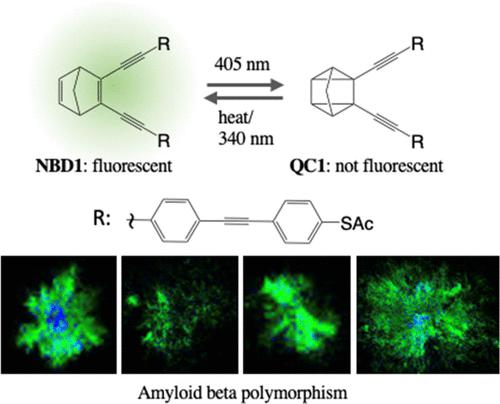Our official English website, www.x-mol.net, welcomes your
feedback! (Note: you will need to create a separate account there.)
Investigating New Applications of a Photoswitchable Fluorescent Norbornadiene as a Multifunctional Probe for Delineation of Amyloid Plaque Polymorphism
ACS Sensors ( IF 8.2 ) Pub Date : 2023-03-22 , DOI: 10.1021/acssensors.2c02496 Ambra Dreos 1, 2 , Junyue Ge 1 , Francisco Najera 2, 3 , Behabitu Ergette Tebikachew 4 , Ezequiel Perez-Inestrosa 2, 3 , Kasper Moth-Poulsen 4, 5, 6, 7 , Kaj Blennow 1, 8 , Henrik Zetterberg 1, 8, 9, 10, 11, 12 , Jörg Hanrieder 1, 9
ACS Sensors ( IF 8.2 ) Pub Date : 2023-03-22 , DOI: 10.1021/acssensors.2c02496 Ambra Dreos 1, 2 , Junyue Ge 1 , Francisco Najera 2, 3 , Behabitu Ergette Tebikachew 4 , Ezequiel Perez-Inestrosa 2, 3 , Kasper Moth-Poulsen 4, 5, 6, 7 , Kaj Blennow 1, 8 , Henrik Zetterberg 1, 8, 9, 10, 11, 12 , Jörg Hanrieder 1, 9
Affiliation

|
Amyloid beta (Aβ) plaques are a major pathological hallmark of Alzheimer’s disease (AD) and constitute of structurally heterogenic entities (polymorphs) that have been implicated in the phenotypic heterogeneity of AD pathology and pathogenesis. Understanding amyloid aggregation has been a critical limiting factor to gain understanding of AD pathogenesis, ultimately reflected in that the underlying mechanism remains elusive. We identified a fluorescent probe in the form of a turn-off photoswitchable norbornadiene derivative (NBD1) with several microenvironment-sensitive properties that make it relevant for applications within advanced fluorescence imaging, for example, multifunctional imaging. We explored the application of NBD1 for in situ delineation of structurally heterogenic Aβ plaques in transgenic AD mouse models. NBD1 plaque imaging shows characteristic broader emission bands in the periphery and more narrow emission bands in the dense cores of mature cored plaques. Further, we demonstrate in situ photoisomerization of NBD1 to quadricyclane and thermal recovery in single plaques, which is relevant for applications within both functional and super-resolution imaging. This is the first time a norbornadiene photoswitch has been used as a probe for fluorescence imaging of Aβ plaque pathology in situ and that its spectroscopic and switching properties have been studied within the specific environment of senile Aβ plaques. These findings open the way toward new applications of NBD-based photoswitchable fluorescent probes for super-resolution or dual-color imaging and multifunctional microscopy of amyloid plaque heterogeneity. This could allow to visualize Aβ plaques with resolution beyond the diffraction limit, label different plaque types, and gain insights into their physicochemical composition.
中文翻译:

研究光开关荧光降冰片二烯作为多功能探针描绘淀粉样蛋白斑多态性的新应用
β 淀粉样蛋白 (Aβ) 斑块是阿尔茨海默病 (AD) 的主要病理标志,由结构异质实体(多晶型物)组成,这些实体与 AD 病理学和发病机制的表型异质性有关。了解淀粉样蛋白聚集一直是了解 AD 发病机制的关键限制因素,最终反映出潜在的机制仍然难以捉摸。我们发现了一种可关闭光开关降冰片二烯衍生物 (NBD1) 形式的荧光探针,其具有多种微环境敏感特性,使其适用于先进荧光成像(例如多功能成像)中的应用。我们探索了 NBD1 在转基因 AD 小鼠模型中原位描绘结构异质 Aβ 斑块的应用。 NBD1 斑块成像显示,成熟核心斑块的外围具有较宽的发射带,而密集核心具有较窄的发射带。此外,我们证明了 NBD1 到四环烷的原位光异构化和单个斑块中的热恢复,这与功能和超分辨率成像中的应用相关。这是首次将降冰片二烯光开关用作 Aβ 斑块病理原位荧光成像的探针,并在老年 Aβ 斑块的特定环境中研究了其光谱和开关特性。这些发现为基于 NBD 的光开关荧光探针的超分辨率或双色成像以及淀粉样蛋白斑异质性的多功能显微镜的新应用开辟了道路。 这可以以超出衍射极限的分辨率可视化 Aβ 斑块,标记不同的斑块类型,并深入了解其物理化学成分。
更新日期:2023-03-22
中文翻译:

研究光开关荧光降冰片二烯作为多功能探针描绘淀粉样蛋白斑多态性的新应用
β 淀粉样蛋白 (Aβ) 斑块是阿尔茨海默病 (AD) 的主要病理标志,由结构异质实体(多晶型物)组成,这些实体与 AD 病理学和发病机制的表型异质性有关。了解淀粉样蛋白聚集一直是了解 AD 发病机制的关键限制因素,最终反映出潜在的机制仍然难以捉摸。我们发现了一种可关闭光开关降冰片二烯衍生物 (NBD1) 形式的荧光探针,其具有多种微环境敏感特性,使其适用于先进荧光成像(例如多功能成像)中的应用。我们探索了 NBD1 在转基因 AD 小鼠模型中原位描绘结构异质 Aβ 斑块的应用。 NBD1 斑块成像显示,成熟核心斑块的外围具有较宽的发射带,而密集核心具有较窄的发射带。此外,我们证明了 NBD1 到四环烷的原位光异构化和单个斑块中的热恢复,这与功能和超分辨率成像中的应用相关。这是首次将降冰片二烯光开关用作 Aβ 斑块病理原位荧光成像的探针,并在老年 Aβ 斑块的特定环境中研究了其光谱和开关特性。这些发现为基于 NBD 的光开关荧光探针的超分辨率或双色成像以及淀粉样蛋白斑异质性的多功能显微镜的新应用开辟了道路。 这可以以超出衍射极限的分辨率可视化 Aβ 斑块,标记不同的斑块类型,并深入了解其物理化学成分。











































 京公网安备 11010802027423号
京公网安备 11010802027423号